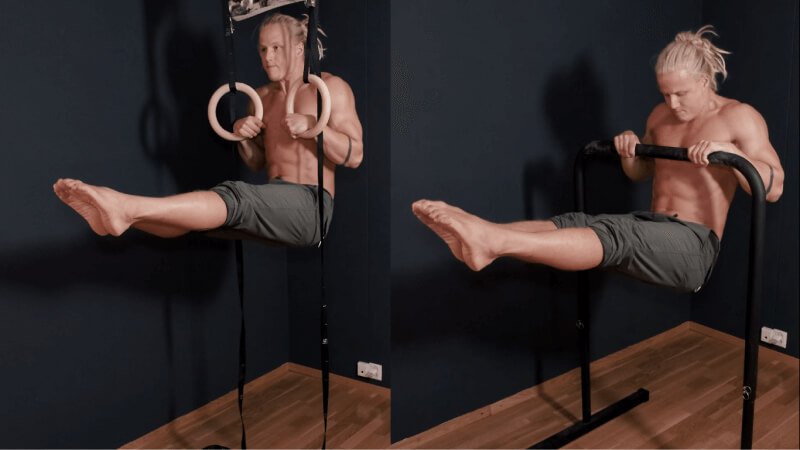Muscle-Up in 3 steps - How to do the Slow Muscle-Up
The muscle-up is an impressive and cool skill that, once your pull up and dip have been mastered, is an achievable challenge to strive for. In this tutorial I will go over how to do the slow muscle up (using a “false grip”), as opposed to the explosive muscle up. I will do up another tutorial for you guys for the explosive muscle-up.
Check out the full video tutorial on the slow muscle-up for rings and bar
We will attack the muscle-up (be it on rings, or bar) by breaking it down into three parts. As well, I will go over tips on how to avoid injury while training for the muscle-up, how to use a so-called “false grip”, how to use bands to aid in your progress, and specifically what exercises to train and how to do them so that you, too, can be that cool guy, or gal in the gym rocking muscle-ups.
Slow muscle-up tutorial - Table of contents:
Muscle up Introductions: 0:00-1:42
Pull Strength for Muscle up: 1:43-3:10
Push Strength for Muscle up: 3:11-4:28
Muscle up Transition: 4:29-4:40
How to False Grip: 4:42-6:28
Muscle up Transition drills: 6:30-8:20
Muscle-up steps
The muscle up can be broken down into three parts: the pulling part, the pushing part, and last but certainly not least, the transition/false grip. The transition, in fact, is where most people have a lot of trouble. Many people can perform pull ups and dips very well - perhaps even weighted - but not be able to do a muscle up. Let’s break down each of these three parts of the muscle up and talk about where we need to be with each of them to achieve a muscle up, and how to get there.
Training Muscle Up Pull Strength
If you’re interested in how to do a muscle-up, presumably you are already very comfortable with the pull up. The muscle-up requires a high level of pulling strength, where you will use your lats, rear delts, traps, and biceps.
Once you are comfortable with pull ups, you should specifically start to focus on performing high pull ups. What I mean by high pull ups is, when you perform the pull up, trying to pull all the way until your chest is at the bar. As you get better at this, you should try to pull even higher, so that you can bring your solar plexus to the bar.
High pull ups on the rings and the bar, while in an L-sit position
Once you are able to do this, you can then work through these progressions again, except performing the pull ups in the L-sit position. Being able to do these pull ups in the L sit position will transfer over to the muscle-up by making it easier technique-wise. Note, however, that it is something you will need to work at for some time and get used to. Doing a pull up in the L-sit position requires a very high level of core strength.
To get used to doing pull ups at these new ranges of motion, you may want to introduce using bands. As performing the high pull up with the bands gets easier, try to progressively reduce the thickness of the band until you are able to do the pull ups in good form and, eventually, without the band. Remember to focus on keeping your movement slow and controlled, as in this case we are working toward the slow muscle-up, not the explosive muscle-up.
Whether it’s to improve your high pull up, your deep dip, or your false grip, bands are a helpful tool in improving each aspect of the muscle-up. But remember to use it as an intermediate step between progressions - in other words, use bands that aren’t too thick
A few technical cues for the muscle-up
I recommend you begin to introduce the false grip as early as possible, which I will dive into below. Performing the high pull ups with a false grip will ensure maximum relevance for the slow muscle up.
One very important thing to keep in mind, for all of these variations, is to keep your elbows tucked. By this I mean, keep your elbows close to your body. This will make the muscle up easier and will also prevent injury.
An important thing to keep in mind: keep your elbows tucked.
The Push strength for muscle-up
While the push part of the muscle-up is not where most people struggle, it is still of course an important aspect of the muscle-up.
Depending on whether you are working towards a bar muscle-up or a ring muscle-up, it is important to develop a nice, deep dip on the relevant equipment. Even if you are not working towards a ring muscle-up, however, I do recommend you still include ring dips in your training. It’s an excellent exercise for building relevant strength for the muscle-up.
An example of a deep dip, using a band as help. Remember to use a band only when needed, and to get rid of it when you have built sufficient strength.
If you are not able to do an unaided deep dip yet, use bands as required, until you can do them without. On the other hand, if you are comfortable with your dips, you can consider turning your hands outwards at the peak of your dip repetition, to make it more difficult and continue to increase relevant strength for the muscle-up.
Slow Muscle up Training Program
If you want a stepwise, structured guide to working on the muscle up through specific muscle-up workouts, head over to my app. It’s free to try and already has close to 1,000 workout progressions, all with written form cues and descriptions on how to do the exercises. As well, there are student discounts available and even scholarships for those who are interested but are financially disadvantaged.
The Transition, and False Grip
False grip can be used on rings or a bar. I consider it slightly more difficult on bar, as it required more wrist mobility
The transition is where most people struggle when trying to perform a muscle-up - so hopefully you haven’t given up on reading yet. In my opinion, the transition should be approached all on its own and should be specifically trained for.
In order to train the transition, though, we need to learn the false grip. With the false grip, rather than holding the rings or bar as you usually would, you put more of your hand over the bar, and flex your wrist, as pictured. It will feel very weird at first, but once you are able to perform pull ups with a false grip, it will make the slow muscle-up way, way easier.
For most, when performing the muscle-up, trying to introduce the false grip will be weird, at first, for the pull-up part and the transition. However, the false grip has no effect on the dip. The movement for the dip part of the muscle up will be the same as the one that you’ve traditionally trained.
The false grip can be used on rings or bars but it is, in my opinion, easier to do on rings. When using rings your wrists can move freely around, whereas when using bars your hand is anchored in one place and your wrists are given less play. Using the false grip on the bar will require more wrist mobility.
To get more comfortable with this style of grip, at first it may be helpful to use rubber bands and also to do half-reps. With a half-rep you are only doing the first half or the second half of the ROM with each rep. As you get more comfortable you can get rid of the rubber bands and then, later on, begin to work on full pull ups using the false grip. Once your false grip is strong enough to use in your pull training, you can then start to work on your transition using the false grip.
Another look at the false grip
Steps to progressing your muscle up transition
Once you are able to do pull ups using the false grip, you are ready to work on your transition. Perfecting the transition will have the biggest effect on our progression towards the muscle up. Here are the steps I would go through to master a smooth transition for a slow muscle-up:
Using a false grip, hold a locked position with your chest at the bar, i.e. the top position of a pull up. If this requires too much strength, at first you may set something up under your feet to provide support, and switch from left foot to right foot every 1-2 seconds. You can also train this position using a resistance band. Remember, when holding this position, to keep your elbows tucked.
Introduce small swings. At first you may use resistance bands until you get used to this movement.
Introduce bigger swings.
Introduce dip transition. Starting from a deep dip, transition into the position where it is like you are at the top of a pull up. I.e., switch from the position where you are at the bottom of a dip, to the top of a pull-up. The most notable change between these two positions will be seen in your elbows. They will go from pointing up, to pointing down at the floor. At first, do the transition and just hold.
Go back and forth between deep dip position to top pull-up position/”transition position”.
Deep dip transition for the muscle up
It will take time for all of this to come together regarding the transition, but it will come together. When you’re able to go through these 5 steps, it’s just a matter of merging the pull, the transition, and the push all into one fluid movement to perform the full muscle-up. Don’t necessarily expect, though, that once you are able to do step 5, that you will automatically be able to do a full muscle-up. Work up to being able to do step 5 for reps, perhaps doing 3-5 reps for several sets.
Along with your transition work, continue to work on your high pull-up using a false grip as well as your deep dip. When you’re ready, you can start to work on the full muscle up with rings or bar. I recommend working on the full MU at the beginning of your workout, after your warm up, and then continuing to work on your high pull up, deep dip and transition after that :).
muscle up with rings
progression for muscle up
In summary, how to do a muscle-up:
The first step to doing a muscle up with rings or on the bar, is to master your pull-up. Work up to being able to do a high pull-up, i.e. a pull-up where you can pull your solar plexus up to the bar, while in the L-sit position.
The next progression for muscle up is to master your deep-dip.
Third is to master the transition and using a false grip.
Good luck, and let me know how it goes with the muscle-up! Take care, movers :)










